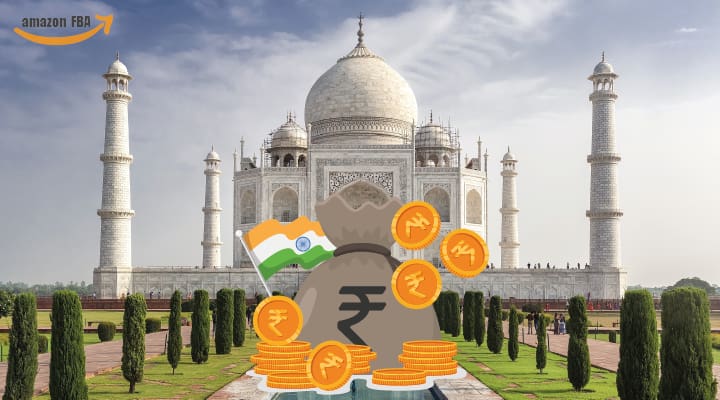
Fulfillment by Amazon (FBA) has become a popular choice for sellers in India who want to leverage the vast customer base and resources of the e-commerce giant. With FBA, Amazon stores, packs, and delivers products to customers, allowing sellers to focus on other aspects of their business. However, this convenience comes at a cost, and sellers must understand FBA fees in India.
The fee structure for FBA in India includes a mix of fixed and variable charges. Fixed fees include monthly storage costs, while variable fees are based on the dimensions and weight of the products being shipped. FBA fees also cover services like customer service and returns handling, making it an all-inclusive solution for sellers. Understanding and calculating these fees is crucial for sellers to determine their potential profits and manage their business effectively.
Sellers can use tools like the Amazon FBA fee calculator to estimate their expenses accurately. This calculator helps determine packaging, shipping costs, and total FBA fees, allowing sellers to decide their pricing strategy. It is crucial for sellers to periodically review their fee structure, as shifts in this structure can directly impact their profitability.
Understanding Basic Amazon FBA Fees India
When selling on Amazon India using Fulfillment by Amazon (FBA), it is essential to be aware of the various fees associated with the service, as these fees directly impact your overall earnings. This section will provide an overview of three primary fee types: Referral Fees, Closing Fees, and Shipping Fees.
Referral Fees
Amazon charges referral fees for each item sold in a particular category. These fees are based on a percentage of the item’s sale price. The percentage differs depending on the category of the product. Checking the Amazon Seller Fee & Pricing can offer more insight into specific referral fee percentages for your products.
Closing Fees
Closing fees are charged for specific categories like Media, including books, video games, DVDs, and music. This fee is fixed per item, regardless of the selling price. This fee may vary depending on Amazon’s policies, and sellers should monitor the Amazon FBA Fee and Pricing for any changes.
Shipping Fees
Shipping fees, or Weight Handling Fees, are charged based on the weight and dimensions of the item, as well as the shipping destination. These fees include packing, transporting, and delivering the products to the customer. A great way to estimate these fees is by using the Amazon Seller Calculator.
In addition to the above-mentioned fees, FBA sellers should consider storage fees and other potential charges, such as long-term or removal fees. Keeping track of these fees enables sellers to make informed pricing decisions and maximize their profits using Amazon FBA in India.
Other Fees
Check fees here
Pick & Pack Fee
Amazon FBA India charges a Pick & Pack fee for each unit sold through the program. This fee covers picking the product from its storage location and packing it for shipment to the customer. The exact cost will depend on the size and weight of the item. This price is ₹13 for standard items, and for oversized, heavy, and bulky things, it is ₹26.
Storage Fee
Amazon charges a storage fee for items in their warehouse. Storage fees are typically calculated in cubic feet and charged monthly by ₹45.
FBA Removal Fees
You must pay a removal fee to remove inventory from the Amazon FBA warehouse. The fee structure depends on the weight and size of the products. For example, a standard-size item weighing less than 1 kg will incur a removal fee of ₹15 per unit, while an oversized item weighing between 30 and 60 kg is charged ₹300 per unit. If you dispose of the inventory, you’ll be charged a disposal fee following a weight-based fee structure as removal fees.
| Weight | Removal Fee per unit | Disposal Fee per unit |
|---|---|---|
| Standard size | ₹10 | ₹10 |
| Heavy & Bulky | ₹100 | ₹100 |
Cost-Saving Strategies with Amazon FBA Fees India

Amazon’s Fulfillment by Amazon (FBA) service in India is a powerful tool for business owners looking to increase their reach and expand their market. However, keeping costs minimal is vital for long-term success. With that in mind, here are some strategies to help you save on FBA fees in India.
First, consider packaging optimization. The shipping fees are based on the weight and dimensions of your product, so it is sensible to reduce the size and weight of your packaging. Consider using lightweight materials and efficient packaging designs to save on shipping fees.
Another approach to reduce FBA costs is taking advantage of inventory management tools available on Amazon’s Seller Central. Use these tools to monitor your inventory levels and ensure you’re neither understocked nor overstocked. Overstocking leads to additional storage fees, while understocking results in lost sales.
Further, when listing your products, choose the correct product category. Amazon charges fees based on your product’s category, and selecting the incorrect category might subject you to higher fees than necessary. Take the time to research and confirm the appropriate category to save on fees.
Frequent analyses of your Amazon FBA fees can help you identify new cost-saving opportunities. Regularly reviewing your fees can shed light on any discrepancies or areas where you might be spending more than needed. This can lead to a better understanding of how to optimize your fulfillment process.
Lastly, consider consolidating shipments, which means sending multiple products in one shipment to the FBA warehouse. By doing so, you can lower your overall shipping fees since the cost of shipping multiple items together tends to be more economical.
In conclusion, implementing these strategies will help reduce your FBA fees in India and improve your profitability. While each seller’s situation is unique, combining these tactics can ensure minimal costs while taking advantage of FBA services’ benefits.
Importance of Monitoring Amazon FBA Fees India
Fulfillment by Amazon (FBA) has become a popular choice for many Amazon sellers globally due to its convenience and wide range of services. However, these sellers must keep track of their incurred FBA fees to maintain profitability and overall business performance.
Amazon India FBA fees comprise storage fees, fulfillment fees, and returns. Keeping a tab on these variable costs allows sellers to understand their profit margins and identify areas for improvement. Moreover, tracking these fees can highlight inconsistencies and errors, enabling business owners to seek reimbursement or adjustments from Amazon if necessary.
Another aspect to consider is the impact of FBA fees on pricing strategies. The careful monitoring of FBA fees can help sellers adjust their prices, ensuring they remain competitive while covering the costs of using Amazon’s services. This data-driven approach enables better inventory management, as sellers can prioritize fast-moving products and dispose of slow-moving or non-performing items to optimize their storage costs.
Utilizing an FBA fee calculator can be beneficial in understanding the specific costs associated with different product categories, shipment charges, and storage charges. By inputting product details, sellers can quickly view a breakdown of fees, making it easier to manage expenses and gain valuable insights for decision-making.
Lastly, incorporating monitoring practices into daily operations can help businesses adapt more effectively to Amazon FBA fee structures and policy changes. By staying informed and adjusting their operations accordingly, sellers can ensure a more sustainable and successful business in the long term.
Effective Strategies to Minimize FBA Fees India

Keeping the FBA fees in check is crucial for sellers on Amazon India to maximize their profit margins. Here are several strategies that sellers can employ to achieve this goal efficiently:
1. Optimize Product Selection: Choose products with a higher selling price and faster turnover to ensure storage fees don’t waste your profits. Prioritize high-demand items and avoid low-selling items that may accumulate storage fees.
2. Bundle Products: Bundling products together can help reduce the number of individual units that need to be picked and packed by Amazon, leading to savings on fulfillment fees.
3. Review Package Dimensions and Weights: Ensure that the dimensions and weights of your products are accurately listed in your seller account. Amazon may overcharge fees based on incorrect information.
4. Monitor Inventory Levels: Practice effective inventory management by frequently monitoring your stock levels at Amazon FBA warehouses and adjusting the sales velocity accordingly. This helps avoid long-term storage fees.
5. Leverage Amazon’s FBA Fee Discounts: Amazon sometimes offers discounts and promotions for FBA fees. Keep an eye on these offers to take advantage of lower costs.
6. Utilize FBA Small and Light Program: Consider enrolling in Amazon India’s FBA Small and Light program for small and lightweight products, which offers lower fulfillment fees for qualified items.
7. Opt for Multi-Channel Fulfillment: If you sell on multiple platforms, consider using FBA Multi-Channel Fulfillment to benefit from combined shipping savings while still enjoying the same fulfillment service FBA provides.
In conclusion, sellers on Amazon India must constantly evaluate their strategies to minimize FBA fees. By optimizing product selection, bundling products, managing inventory levels, and keeping an eye on discounts, sellers can effectively reduce FBA fees and maintain healthy profit margins.
Future Predictions for FBA Fee Structure in India
India’s Amazon FBA (Fulfillment by Amazon) fee structure has evolved. As the platform gains more traction among sellers and shoppers, the fee structure is expected to continue to adapt to changing market conditions. Here, we present some possible trends and changes to expect moving forward.
One potential change could be increased storage fees at Amazon’s fulfillment centers. As the number of sellers utilizing FBA grows, the demand for storage space will also rise. Consequently, storage fees may increase, pushing sellers to optimize their inventories and ensure regular stock rotation to minimize storage costs.
Meanwhile, shipping fees might also adjust due to fluctuations in fuel prices and transportation costs. The FBA calculator might need to factor in these changes, allowing sellers to understand the updated fee structures and make appropriate pricing decisions.
Furthermore, Amazon may introduce regional variations in FBA fees due to differences in labor, transportation, and operating costs across the country. This could lead to lowering fees in areas where costs are more favorable while raising fees in regions with higher operating expenses. These regional discrepancies may encourage sellers to strategically choose the location of their fulfillment centers based on cost considerations.
An additional trend to anticipate is a focus on maintaining the balance between Amazon’s profits and supporting the growth of third-party sellers. Ensuring a fair pricing policy for FBA services will help maintain healthy competition on the platform. This could materialize through fee adjustments, updated billing cycles, or even introducing new tiers for various fulfillment services.
In summary, the future of the FBA fee structure in India will likely be shaped by factors such as increased demand for storage space, changes in transportation costs, regional variations in operating costs, and the need to maintain a balance between Amazon’s profitability and third-party seller support. While it is impossible to predict the exact changes, sellers need to stay informed about the FBA fee updates and adjust their business strategies accordingly.
FBA Fees in the United States
In the United States, FBA (Fulfillment by Amazon) Fees represent the expenses tied to availing Amazon’s storage and delivery services. Sellers opting for FBA send their items to Amazon’s distribution hubs. From there, Amazon handles storage, selection, packaging, and dispatching of these items directly to buyers on the seller’s account.
Frequently Asked Questions
Check more questions about FBA India here.
How do Amazon seller charges work in India?
Amazon seller charges in India primarily consist of referral fees and FBA fees. Referral fees are charged as a percentage of each product’s selling price and vary depending on the product category. FBA fees include storage, packaging, and shipping fees, which depend on item size, weight, and storage duration.
What factors affect FBA fees in India?
FBA fees in India are influenced by several aspects, including:
- Item size and weight: Larger and heavier items have higher fees due to increased storage and shipping costs.
- Storage duration: Longer storage periods at Amazon’s fulfillment centers can increase storage fees.
- Seasonality: Storage fees may change based on the time of the year, for example, during peak holiday seasons.
Researching and understanding FBA fees for your specific products is essential to estimate overall costs accurately.
How can I calculate Amazon India referral fees?
You can use the FBA Calculator Amazon provides to calculate Amazon India referral fees. It helps estimate referral and FBA fees based on product dimensions, weights, and selling prices. Additionally, you can refer to the Amazon fee structure for category-specific referral fees.
Are there any specific Amazon shipping charges for India?
Amazon FBA shipping charges in India depend on item weight, dimension, shipping location, and shipping method. Considering these charges while setting your product prices and calculating overall expenses is crucial to ensure profitability.
What is Amazon India’s commission rate across different categories?
Amazon India’s commission rates, or referral fees, vary across different product categories. Rates can range from 6% to 45% of an item’s selling price. Some categories, such as books and office products, have lower referral fees, while others, like jewelry and accessories, have higher fees. To determine exact commission rates for specific categories, refer to Amazon’s fee structure.
How to determine profitability for FBA in India 2023?
To determine profitability for FBA in India, consider product costs, Amazon fees (referral fees and FBA fees), and shipping charges. Calculate your net profit by subtracting these costs from your selling price. Use tools like the Amazon FBA calculator or accounting software that can assist with revenue and expense tracking for a more accurate estimate. Remember that market dynamics, competition, and customer preferences can change, affecting profitability. So, regularly reviewing and updating your pricing and cost strategies is crucial for success in the long run.
Denes, with 20 years experience in logistics, holds a Logistics Manager degree from Budapest’s Logistics Association and has penned a thesis on mobile devices. Venturing into e-commerce, Denes specializes in Fulfilled By Amazon and passionately educates others about Amazon selling techniques.